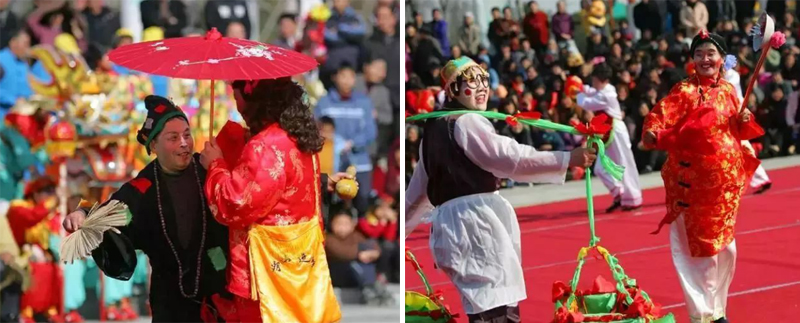Intangible cultural heritages, Zhang Renya's Former Residence, Zhang Renya's Study for Party Constitution, Former Site of Meishan Saltworks, Zhenhaikou Coastal Defense Relics, Beacon Tower of Zongtai Mountain, Chaiqiao Old Street and Guoju Ancient City.
Zhang Renya's Former Residence - A Red Tourism Site

It’s a provincial cultural-relics protection unit. Sited at No. 19, East Xianan Road, Xianan Village, Xiapu Neighborhood, Beilun District, Zhang Renya’s Former Residence is dubbed as the "Post-ancestral Hall" among local residents. This triple-house courtyard was constructed in the middle of the Qing Dynasty. Zhang Renya once lived here between 1898 and 1914. Today, there're a principal house, and a wing house respectively at the east and the west. The courtyard is surrounded by walls, with a gate opened at the middle of the south wall. Framed with boulder strips, it looks similar to a hard-peak arc gateway with bricks on its top.
Address: No. 19, East Xianan Road, Xianan Village, Beilun District
Bus: Xiapu Station of Bus Lines 711, 712, 783 and 720
Zhang Renya's Study for Party Constitution - A Red Tourism Site
Zhang Renya, formerly named as Zhang Jingquan, was born in Xiapu of Beilun in 1898. On October 31, 2017, General Secretary Xi Jinping led the new members of the Standing Committee of Politburo of the Central Committee to visit Shanghai to pay tribute to the memorial hall of the "1st NCCPC" meeting site. When the instructor introduced that the CPC member who reserved the first Chinese translation version of The Communist Manifesto was named Zhang Renya, the general secretary cordially asked, "What about the person you mentioned? What happened to him(Zhang Renya) then?"
Zhang Renya, asked about by the general secretary, was an early member of CPC, leader of the Shanghai Gold and Silver Industry Workers Movement, member of the Soviet Central Workers and Peasants Procuratorate Committee, and director of the Central Publishing Bureau. He served as Secretary of the CPC Wuhu County Committee (equivalent to secretary of CPC Anhui Provincial Committee!). Though surrounded by white terror, he showed scarcely any concern of his personal safety and reserved a great number of precious early-time literature materials that feature tremendous literal and legacy values for the Party. Acclaimed as the "mysterious safeguard" of the first Party constitution of CPC, he died at age 34.
According to incomplete statistics, there are 26 documents collected in the National Museum of China and the commemorative museum of the meeting site of the "1st NCCPC" among all those reserved by Zhang, with 16 rated as the national Class I protection cultural relics.
Zhang Renya’s Study for Party Constitution is a study to chiefly exhibit Zhang's protection of the first Party Constitution of CPC. Welcoming Party member visitors one another, it has become a red tourism site renowned in the province.
Address: No. 210, Middle Xiapu Road
Bus: Xiapu Station of Bus Lines 711, 712, 783 and 720
Meishan Saltworks Museum

Established in April 1968, Meishan Saltworks Museum is a provincial-level cultural relics protection unit. Put into service in 1959, it was awarded the banner to "May the entire nation benefited from Meishan Saltworks" by the then Ministry of Light Industry. Known also as the "Youth Building", the museum sits at northwest to face southeast in a brick-wood structure. Occupying an area of 1793.4m2, it features a four-slope roof, grey foreign tiles and an architectural style similar to the former Soviet Union. With 19 rooms arranged from east to west, there are totally 72 rooms, called the "72 tenant rooms" among folks.
Address: Meiyuan Hotel, Meishan Bonded Port Area
Bus: Lines 792, 712, 790, or Inter-regional Express
Zhenhaikou Coastal Defense Relics
As a milestone in the history of China's coastal defense, Zhenhaikou Coastal Defense Relics was listed as a national key cultural relics protection unit in 1996. Jinji Mountain and Zhaobao Mountain, standing as opposite at the estuary to Yongjiang River, have long been billed as the "Gateway to East Zhejiang", which made noteworthy contribution to the fight against "Japanese pirates, British army, French army and Japanese invaders".
The site consists of over 30 military relics such as the battery, fortress and beacon tower. Qi Jiguang, Zheng Chenggong, Lin Zexu, and Ouyang Lijian also left heroic deeds here. A visit to Jinji Mountain could remind you of the soul of the Chinese nation and stimulate your patriotic enthusiasm.
Address: Jinji Mountain, Qijiashan Street
Bus: Lines 720 and 784
Chaiqiao Old Street
Beilun Chaiqiao Old Street features a long history, business prosperity and convenient transportation. Known as the "Little Ningbo" in ancient times, the street is in an L shape, 1335m long and 7-8m wide. The well-preserved street is the best witness to its boom in ancient times. Though it's gone, the prosperity has left traces in those timeworn streets.
Chaiqiao is a coastal town opened as a commercial port earlier in Ningbo. Allegedly, the thriving of Chaiqiao is related to the proposal to "cut through the mountain, built dikes to encircle the river, and cut three holes on the rocks at west dike as the water gate" raised by Wang Anshi, magistrate of Jinxian County during Renzong Emperor's reign in Song Dynasty. After cutting through the mountain and building dikes to encircle the river, towns began to spring up by the bank of Lujiang River and develop gradually into boom to become a CBD in east of Chuanshan Peninsula.
In the 10th year of the reign of Qing's Emperor Guangxu, namely 1884 A.D., there were ships berthing at the Chuanshan Port, not far from Chaiqiao. Ships sailing to and back from Hu, Yong, Dinghai, and as far as Haimen and Wenzhou, made it an important traffic hub. With freights of Guoju, Kunting, Sanshan, Chaiqiao, Xiapu, Xinqi and even Dongxiang of Jixian County all gathered here, it gradually rose to the reputation of "Little Ningbo in Chaiqiao".
Guoju Ancient City
Established during Hongwu Emperor's reign in Ming Dynasty, Guoju is a historical and cultural town renowned in the province for long-standing history and abundant natural/humanistic resources. In 1387 A.D., to defend against the harassment of Japanese pirates, Guoju locals built up a magnificent city of great defense in the remote hill plain in the coastal area. Today, though the ancient walls disappeared and only a section of the moat is left, there are nearly 60 time-honored houses, 400 years old in average and 600 to the most, reserved in the city.
Beacon Tower of Zongtai Mountain
 Zongtai Mountain of Guoju is situated on the Chuanshan Peninsula at the east end of the land at 30 degrees north latitude. As a relic marking the fight against Japanese pirates and a provincial-level cultural relics protection unit, the beacon tower of Zongtai Mountain continued its service in Qing Dynasty, taking charge of five beacon towers of Gaoshan, Tuze, Guanshan, Meishan, etc. During the Ming and Qing Dynasties, the beacon fire to signal the fight against Japanese pirates, British army and French army was first ignited here. It is a city-level tourism base for hiking and leisure.
Zongtai Mountain of Guoju is situated on the Chuanshan Peninsula at the east end of the land at 30 degrees north latitude. As a relic marking the fight against Japanese pirates and a provincial-level cultural relics protection unit, the beacon tower of Zongtai Mountain continued its service in Qing Dynasty, taking charge of five beacon towers of Gaoshan, Tuze, Guanshan, Meishan, etc. During the Ming and Qing Dynasties, the beacon fire to signal the fight against Japanese pirates, British army and French army was first ignited here. It is a city-level tourism base for hiking and leisure.
Intangible Cultural Heritages

Beilun boasts diversified, unique folk cultures and a large variety of intangible cultural heritages such as news singing, paper-cutting, singing books, horse lantern, instep making, stilts walking, Shuihu Boxing, 9-dragon clothing, lion dancing, folk dance, lion and elephant dance, Guoju drum, car light and flea market.


 Zongtai Mountain of Guoju is situated on the Chuanshan Peninsula at the east end of the land at 30 degrees north latitude. As a relic marking the fight against Japanese pirates and a provincial-level cultural relics protection unit, the beacon tower of Zongtai Mountain continued its service in Qing Dynasty, taking charge of five beacon towers of Gaoshan, Tuze, Guanshan, Meishan, etc. During the Ming and Qing Dynasties, the beacon fire to signal the fight against Japanese pirates, British army and French army was first ignited here. It is a city-level tourism base for hiking and leisure.
Zongtai Mountain of Guoju is situated on the Chuanshan Peninsula at the east end of the land at 30 degrees north latitude. As a relic marking the fight against Japanese pirates and a provincial-level cultural relics protection unit, the beacon tower of Zongtai Mountain continued its service in Qing Dynasty, taking charge of five beacon towers of Gaoshan, Tuze, Guanshan, Meishan, etc. During the Ming and Qing Dynasties, the beacon fire to signal the fight against Japanese pirates, British army and French army was first ignited here. It is a city-level tourism base for hiking and leisure. 